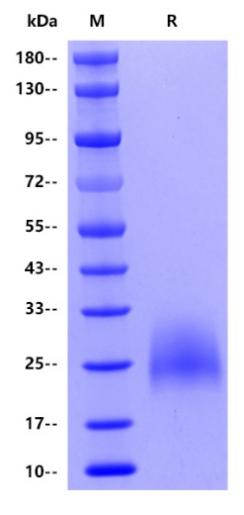Immobilized Recombinant Mouse B7-1 (C-Fc) at 4 μg/mL (50 μL/well) can bind Mouse CD152, his tag with EC50 of 16.27-21.58 ng/mL.
Product Details
Product Details
Product Specification
| Species | Mouse |
| Synonyms | Cytotoxic T-lymphocyte-associated antigen 4 (CTLA-4), Cd152 |
| Accession | P09793 |
| Amino Acid Sequence | Protein sequence (P09793, Glu36-Asp161, with C-10*His) EAIQVTQPSVVLASSHGVASFPCEYSPSHNTDEVRVTVLRQTNDQMTEVCATTFTEKNTVGFLDYPFCSGTFNESRVNLTIQGLRAVDTGLYLCKVELMYPPPYFVGMGNGTQIYVIDPEPCPDSDGGGGSHHHHHHHHHH |
| Expression System | HEK293 |
| Molecular Weight | Predicted MW: 15.6 kDa Observed MW: 20-30 kDa |
| Purity | >95% by SDS-PAGE |
| Tag | with C-10*His |
| Physical Appearance | Lyophilized Powder |
| Storage Buffer | Lyophilized from a 0.2 μm filtered solution of 0.2M PBS, pH7.4. |
| Reconstitution | Reconstitute no more than 1 mg/mL according to the size in deionized water after rapid centrifugation. |
| Stability & Storage | 12 months from date of receipt, -20 to -70 °C as supplied. 6 months, -20 to -70 °C under sterile conditions after reconstitution. 1 week, 2 to 8 °C under sterile conditions after reconstitution. Please avoid repeated freeze-thaw cycles. |
Background
CTLA-4 or CTLA4 (cytotoxic T-lymphocyte-associated protein 4), also known as CD152 (cluster of differentiation 152), is a protein receptor that functions as an immune checkpoint and downregulates immune responses. CTLA-4 is constitutively expressed in regulatory T cells but only upregulated in conventional T cells after activation – a phenomenon which is particularly notable in cancers. It acts as an "off" switch when bound to CD80 or CD86 on the surface of antigen-presenting cells. The CTLA-4 protein is encoded by the Ctla-4 gene in mice and the CTLA-4 gene in humans.
Picture
Picture
Bioactivity
SDS-PAGE

2μg(R: reducing conditions)


